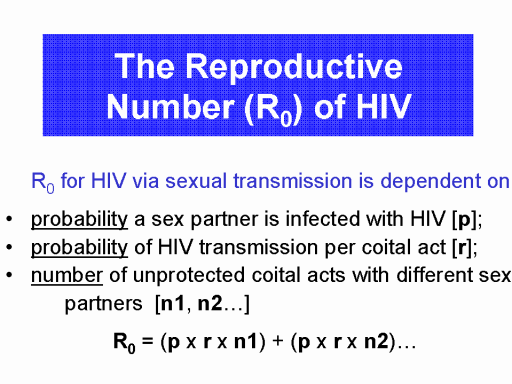| front |1 |2 |3 |4 |5 |6 |7 |8 |9 |10 |11 |12 |13 |14 |15 |16 |17 |18 |19 |20 |21 |22 |23 |24 |25 |26 |27 |28 |29 |30 |31 |32 |33 |review |
 |
The
epidemiologic concept of the reproductive number of an infectious
disease agent (R0)
is very specific and is more useful to describe HIV transmission
dynamics, especially the difference between epidemic and nonepidemic
HIV transmission. R0 describes
in a single value, the epidemic potential of an infectious agent.
When, on average, one infected person infects more than one
other person, R0 is
>1 and the result will be epidemic spread of the agent. When, on
average, one infected person does not infect more than one other
person, R0 is
<1 and epidemic spread does not occur. When R0 is
<1, the infectious agent will slowly disappear and if R0 stays
close to 1 the agent will maintain itself in the population with no
or minimal growth (i.e., becomes endemic).
Because the risk of HIV transmission per coital act (anal or
vaginal) is very low, the R0 of
HIV cannot be >1 unless the number and frequency of sex partner exchange is
high and there are facilitating factors that increase HIV infectivity.
The formula presented in this slide will calculate the annual
R0 of
HIV when the annual numbers of unprotected coital acts with different sex
partners are provided. |